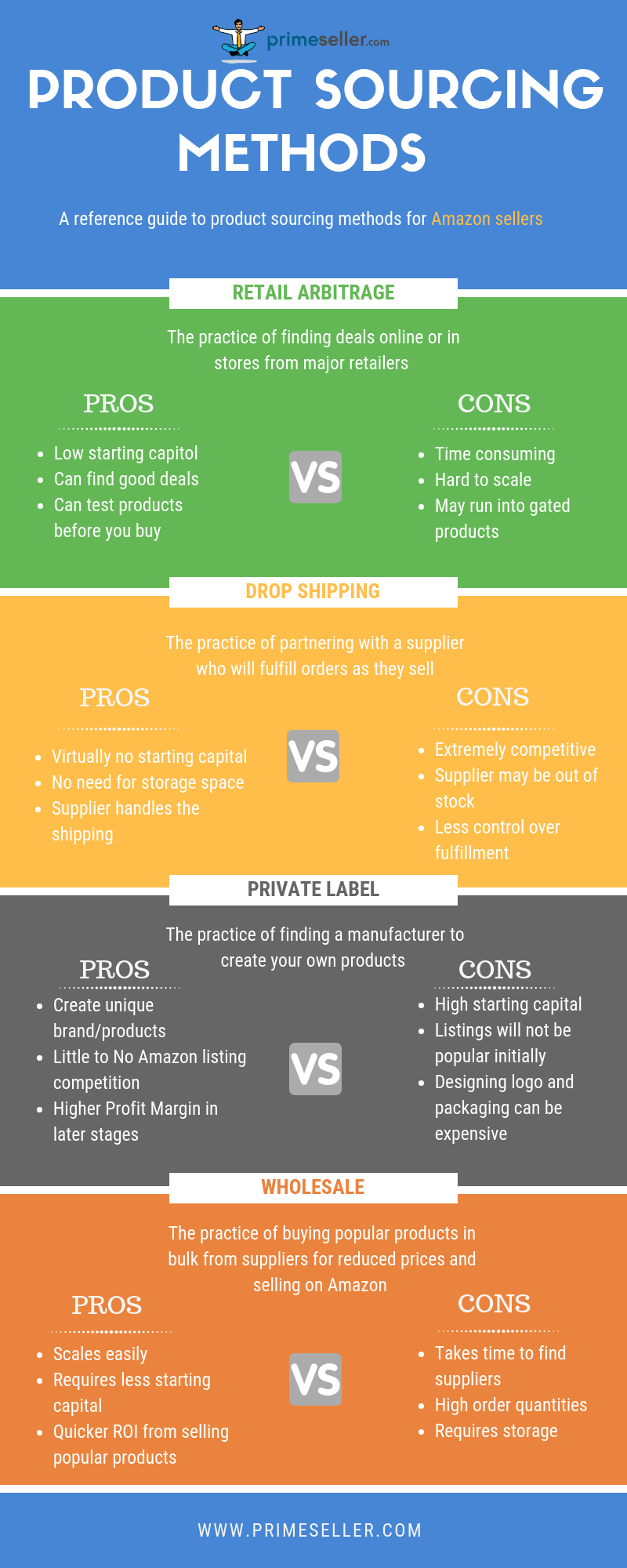Welcome readers! Thanks for joining me on my journey from $0 to $5,000 profits per month by selling on Amazon. There are a lot of ways to make money selling on Amazon, and let’s face it—if you and I are going to become successful selling on Amazon, we need to make sure we’re pursuing a strategy that’s going to work. Today I am going to discuss Amazon Business models. More specifically, I am breaking down some popular product sourcing models. From what I have researched, here are the best business models for selling on Amazon. I have also included SupplySpys Amazon Sourcing Method Cheat Sheet inforgraphic below, as I found that be helpful as well.
Retail or Online Arbitrage
One Amazon business model is Retail or Online Arbitrage. This strategy is where you buy low and sell high by looking for clearance or hugely discounted products on different websites or local stores and then selling them on Amazon. It's possible to find great deals on retail sites like Target, Walmart etc.. and sell the stuff you bought at a discount with a good profit on Amazon.

The biggest advantage of retail or online arbitrage is that it requires pretty low starting capital—as you only buy limited amounts of products at really good prices. The biggest disadvantage is that you have to constantly be looking for products which takes a lot of time, and you won’t be able to consistently capitalize on the same thing. And I know there are some good apps for online or retail arbitrage out there to help with this model, but even with the right tools, it’s still tedious and time-consuming to go to each store and scan possibly hundreds of products each day to keep up.
Plus, Amazon is getting more and more strict and sometimes you need a manufacturer’s or brand owner’s approval to sell certain brands on Amazon. So it’s possible you could buy something for a good deal, and then be stuck with products that Amazon won't even let you sell.
Drop-Shipping
The next model is Drop-shipping. Dropshipping is really cool, because you have virtually NO need for capital to start, as you don’t actually BUY the products until AFTER you sell them. So how does drop-shipping work on Amazon? You sign up for drop-shipping accounts with different suppliers. You can then list their products on Amazon and have the supplier drop-ship directly to your Amazon customers.

But unfortunately, there are A LOT of disadvantages to having an Amazon drop-shipping business. First, it’s usually extremely competitive and hard to make any revenue , as drop-ship companies are out marketing to as many people as they can, trying to make their products popular. Also, since the drop-ship supplier handles the products for you and provides other services, you will assuredly NOT be getting the lowest prices on products. Plus, you have literally NO control over the process. You can't be sure if the supplier even has the product in stock when you sell it, which might lead to a lot of order cancellations. You might also get a lot of complaints about damaged products, delayed shipments, and similar problems which can eventually lead to your Amazon Seller account getting closed.
Private Label
The third model for selling on Amazon is Private Label. With an Amazon Private Label strategy, you find generic products that are already available, put your own brand on them, and sell on Amazon under the brand that you created.

This model is really cool because you’re making your very own product line. But it requires a lot of capital and all the aspects of product researching including: samples testing, brand creation, manufacturing, and shipping. This means you’re waiting a long time to start earning money. Plus, most private label manufacturers require you buy in large quantities, which means it’s no small amount you’ve invested. In addition, even with really great high-margin products, your listings will not be popular initially. This means it will take even more time and capital to advertise the listings and sell at cheaper prices.
Wholesale
So let’s talk about the Amazon business model I’ve decided to go with. Wholesale. This is my preferred model and it’s the one for which I’ll show you all the specifics details as I build my Amazon wholesale biz from zero to 5K profits per month. The wholesale model just means I’ll buy products in bulk from good suppliers, then I’ll re-sell them on Amazon.

I like wholesale more than Arbitrage because you can scale your business easily. Just find a few good wholesale suppliers, build good relationships, and constantly buy top-selling products from them.
I also like wholesale better than drop-shipping, since you control all the processes and you can use FBA (Fulfilled by Amazon)—to make sure your customers can use Amazon Prime AND qualify for all of Amazon’s standard-setting fulfillment services. Plus by paying upfront and buying in bulk I’ll get way better prices than any drop-shipping model.
And finally Wholesale requires less capital to start than with Private Label, since quantities are lower. And wholesale products arrive much faster. This means it will be possible to make revenue much sooner than with private label.
I’ve decided the total long-term rewards are higher, and the overall risk in selling wholesale on Amazon is much lower, because with the SupplySpy tools, I’ll be able to order high-margin products that I already know are selling well on Amazon. So I’m going to be at a significantly lesser risk for getting stuck with a lot of non-selling products. My very worst case will be selling at break-even prices or taking a small loss if products get hyper competitive.
Summary
So that’s it. Arbitrage, Drop-shipping, and Private Label strategies all have their advantages. But for the sustainable $5k profits per month that I’m trying to reach, Wholesale is going to be the model of choice for me.

Be sure to check my blog for updates as I’ll be sharing links and tools and other info that I hope will be really helpful. Also, find us on YouTube at SupplySpy. I’ll be sharing information and vlog updates on how my journey is going!
SupplySpy offers all the tools you need to start or grow your Amazon selling business. Regardless if you're a new or experienced Amazon seller, we want to help you get the most out of your Amazon business whether that's finding the best products to sell on Amazon, finding domestic wholesalers, or staying up to date on the latest Amazon selling trends and best practices.
Subscribe to start learning Amazon selling tips and tricks for FREE.
